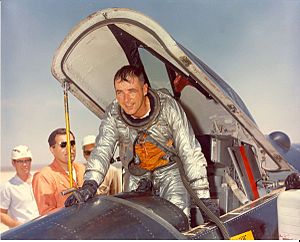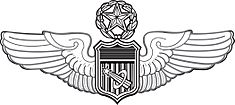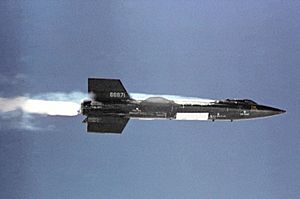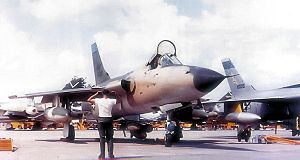Robert Michael White facts for kids
Quick facts for kids
Robert M. White
|
|
|---|---|
 |
|
| Born | July 6, 1924 New York City, U.S.
|
| Died | March 17, 2010 (aged 85) Orlando, Florida, U.S.
|
| Nationality | American |
| Other names | Robert Michael White |
| Alma mater | NYU, B.S. 1951 GWU, MBA 1966 |
| Occupation | Test pilot |
| Space career | |
| USAF Astronaut | |
| Rank | |
| Selection | 1957 MISS Group |
| Missions | X-15 Flight 62 |
| Retirement | February 1, 1981 |
| Military career | |
| Allegiance | |
| Service/ |
|
| Years of service | 1942–1946 1951–1981 |
| Rank | |
| Commands held | 53rd Tactical Fighter Squadron |
| Battles/wars | World War II Korean War Vietnam War |
| Awards | Air Force Cross Air Force Distinguished Service Medal (2) Army Distinguished Service Medal Silver Star (4) Legion of Merit Distinguished Flying Cross (5) Air Medal (17) |
Robert Michael "Bob" White (July 6, 1924 – March 17, 2010) was a brave American Major General in the U.S. Air Force. He was an electrical engineer, a test pilot, a fighter pilot, and even an astronaut.
Bob White was one of only twelve pilots to fly the North American X-15, a special experimental spaceplane. This amazing aircraft was a joint project between the Air Force and NASA. As an engineer, he helped design and develop many modern military planes. On July 17, 1962, he flew the X-15 higher than 50 miles. This flight made him an astronaut, according to the United States' definition of space.
Contents
Early Life and Military Career
Where Was Bob White Born?
Robert White was born in New York City on July 6, 1924. After finishing high school, he joined the military in November 1942. He became an aviation cadet in the U.S. Army Air Forces. By February 1944, he earned his pilot wings and became a second lieutenant.
Serving in World War II
During World War II, White served with the 355th Fighter Group in Europe. He flew P-51 Mustang planes from July 1944 to February 1945. On his 52nd mission, he was shot down over Germany. He was captured and became a prisoner of war until April 1945.
Education and Return to Service
After the war, White returned to the United States in December 1945. He joined the Air Force Reserve and studied Electrical Engineering at New York University. He earned his Bachelor of Science degree in 1951. Later, in 1966, he earned a Master of Business Administration degree from George Washington University.
White was called back to active duty in May 1951 for the Korean War. He served as a pilot and engineer with the 514th Troop Carrier Wing. In February 1952, he became a fighter pilot and flight commander in Japan. He returned to the U.S. in August 1953 to work as a systems engineer at Rome Air Development Center.
Becoming a Test Pilot
White attended the United States Air Force Test Pilot School in Edwards Air Force Base, California. He became a skilled test pilot, flying advanced planes. These included the F-86 Sabre, F-89 Scorpion, F-102 Delta Dagger, F-104 Starfighter, and F-105 Thunderchief. He was promoted to Deputy Chief of the Flight Test Operations Division. Later, he became Assistant Chief of the Manned Spacecraft Operations Branch.
Flying the X-15 Spaceplane
In 1958, White was chosen as the Air Force's main pilot for the North American X-15 program. While the X-15 was being tested, he attended the Air Command and Staff College. He graduated in 1959. His first test flight of the X-15 was on April 15, 1960. The plane had two temporary rocket engines at that time.
Four months later, he flew the X-15 to an amazing height of 136,000 feet (41.5 km). This was above Rogers Dry Lake.
In February 1961, White set an unofficial air speed record. He flew the X-15 at 2,275 miles per hour (3,661 km/h). This was after a more powerful engine was installed. White was the first person to fly an aircraft at Mach 4 and later Mach 5. On November 9, 1961, he flew the X-15 at 4,093 miles per hour (6,587 km/h). This made him the first pilot to fly a winged craft at six times the speed of sound (Mach 6).
Becoming an Astronaut
President John F. Kennedy honored White and three other X-15 pilots with the Robert J. Collier Trophy. The other pilots were Joseph A. Walker of NASA, Commander Forrest S. Petersen of the U.S. Navy, and Scott Crossfield. The next day, Air Force Chief of Staff General Curtis E. LeMay gave White his new rating as a Command Pilot Astronaut.
On July 17, 1962, Major White flew the X-15 to an altitude of 314,750 feet (59 miles, 96 km). This flight earned him USAF astronaut wings. He became the first "winged" astronaut. He was one of the few people to fly into space without a traditional spacecraft. Major Bob White was featured on the cover of Life magazine on August 3, 1962, for his incredible flight.
Later Career and Retirement
In October 1963, White went back to Germany. He served as an operations officer, flying F-105 Thunderchief planes. From July 1964 to August 1965, he commanded a squadron. He returned to the U.S. in August 1965 to attend the Industrial College of the Armed Forces. He graduated a year later.
In May 1967, during the Vietnam War, Colonel White was assigned to Thailand. He flew 70 combat missions over North Vietnam. He led an attack against the Paul Doumer Bridge in Hanoi on August 11, 1967. For this, he received the Air Force Cross. In October, he moved to Seventh Air Force Headquarters in South Vietnam.
White returned to the U.S. in June 1968. He became the director of the F-15 Eagle Systems Program. He was in charge of managing the development and production of the F-15 fighter jet.
On July 31, 1970, White became the commander of the Air Force Flight Test Center. He was responsible for testing manned and unmanned aerospace vehicles. During his time there, testing began on important programs. These included the F-15 fighter, the A-X ground attack aircraft, and the Airborne Warning and Control System. In October 1971, he completed a Naval Test Parachutist course and earned parachutist's wings.
He served at the Flight Test Center until October 1972. The next month, he became the Commandant of the Air Force Reserve Officer Training Corps (AFROTC). He was responsible for the AFROTC program at colleges and universities across the U.S.
White was promoted to major general in February 1975. In March, he became Chief of Staff of the Fourth Allied Tactical Air Force. He retired from active duty on February 1, 1981.
In 1992, White was honored in the Aerospace Walk of Honor. He was also inducted into the National Aviation Hall of Fame in Dayton, Ohio, on July 15, 2006.
Robert M. White passed away on March 17, 2010, at the age of 85.
Awards and Honors
 |
|||||||||||
 |
|||||||||||
| Air Force Command Pilot Badge with Astronaut Device |
|||||||||||
| Air Force Parachutist Badge | |||||||||||
| Air Force Cross | Air Force Distinguished Service Medal with cluster |
Army Distinguished Service Medal | Silver Star with three clusters |
||||||||
| Legion of Merit | Distinguished Flying Cross with four clusters |
Bronze Star | Air Medal with sixteen clusters |
||||||||
| Presidential Unit Citation | Outstanding Unit Award with cluster and "V" Device |
Organizational Excellence Award | NASA Distinguished Service Medal |
||||||||
| Prisoner of War Medal | Army Good Conduct Medal | American Campaign Medal | European-African-Middle Eastern Campaign Medal with three stars |
||||||||
| World War II Victory Medal | National Defense Service Medal with one star |
Korean Service Medal with one star |
Vietnam Service Medal with three stars |
||||||||
| Air Force Longevity Service Award with eight clusters |
Armed Forces Reserve Medal | Small Arms Expert Marksmanship Ribbon | Armed Forces Honor Medal | ||||||||
| Vietnam Gallantry Cross Unit Citation with Palm | United Nations Korea Medal | Vietnam Campaign Medal | Korean War Service Medal | ||||||||
Other Achievements
- 1960 Harmon International Aviators Trophy
- 1961 Collier Trophy, for important contributions to flight and for courage as an X-15 test pilot.
- 1962 John J. Montgomery Award
- 1991 Elected to the American Philosophical Society




